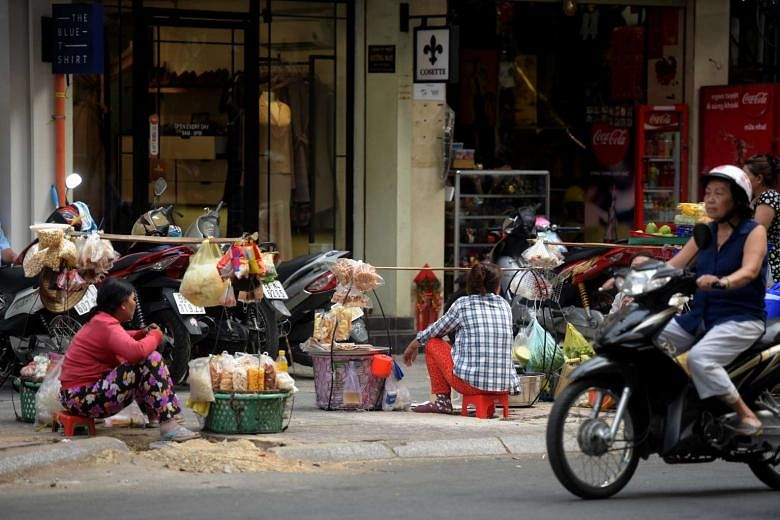From early February , the entire tourist District 1 of Ho Chi Minh City and some districts of Hanoi have been the target of a law enforcement crackdown on sidewalk vendors and encroachment by shops into public space.
An image of a zealous District 1 vice-chairman, Mr Nguyen Ngoc Hai, rolling up his sleeves and pointing his finger at illegal vendors on footpaths went viral, attracting widespread commentary. In Hanoi, however, the crackdown was not such a high-profile one.
The enforcement kicked off another round of a decades-old debate about whether there is too much or too little state authority in Vietnam, and conversely, too much or too little democracy and liberty.
The cleanup campaign's purpose was to clear the footpaths that had been taken over by shops' displays and service tables and chairs. These impeded pedestrian traffic and have long been complained about, even by tourists.
Notable was the fact that even the sidewalk security sentries' kiosks of government agencies of Ho Chi Minh City, including its office of the State Bank, were demolished. Many other commercial kiosks met the same fate without prior warning. Concrete steps leading up to a five-star hotel were demolished without much prior notice - even after a confrontation between hotel management and the wrecking team.
However, the crackdown has proven divisive. There are those who thought the campaign was right, those who stood up for the livelihood of small businesses, and those who thought the methods could have been more carefully considered.
In a nutshell, the issue has been represented as one of livelihood versus municipal rules, as one of democracy versus the need to be disciplined, neat and tidy.
REVIVING BITTER MEMORIES
The crackdown was far more than just an issue of technicalities about who has rights on the footpath. It contains much political significance. In the days after the Vietnamese government opened up the country and began reforms in 1986, the termination of a huge number of state enterprises meant the loss of a huge number of state jobs. This pushed many individuals to having to make a living hawking goods or services on the sidewalk. A popular poem at that time even described discharged army colonels selling ice cream from pushcarts.
Not only those in the city took part in this informal economy - increasingly, more peasants who did not have work flowed into the city to make their daily dollars. The municipal disorder was tremendous, but the jobless had to make a living.
In 1995, after the government felt that people's lives had become easier than before, it started a campaign clamping down on the sidewalk informal economy. Today, more than 20 years later, while the problem is not as severe as in the 1980s through to 1995, the major cities of Hanoi and Ho Chi Minh City still face the problems of crowded footpaths, especially in tourist areas and away from the civic centres where government offices are, and where enforcement is strong.
The sharp divisions in public opinion have probably caused higher officials to rein in Mr Hai of District 1, and to have the crackdown efforts continued at the ward level, a level below the district.
Most pundits agree that the wards, which also rely on taxes from businessmen for some of their income, are likely to turn a blind eye and find a middle-of-the-road solution that will please upper levels but at the same time allow merchants and vendors to carry on. Already this week, netizens are showing photos of the sidewalk returning to the pre-enforcement situation of merchants and vendors.
A related issue that has arisen is that some of the fixed features on Ho Chi Minh City sidewalks that were demolished, in the past had been approved by the local authorities. Affected residents are now demanding compensation.
This is a typical situation in Vietnam, where policy decisions are not thought through, may be partial in implementation, and do not provide longer-term solutions.
On the Internet, Vietnamese often refer to the Singaporean model and the orderliness of the sidewalks of Singapore. I am often at pains to emphasise to them the differences between the two countries. If the street hawkers and vendors are to make a living, they must have a place to do that in new premises as a "pull" factor to get off the street. Singapore has long understood that.
However, the inner cities of Ho Chi Minh City and Hanoi, where most of the money from street vending is to be made, do not have a lot of space to build new markets or food courts.
Also, commercial owners and city officials may prefer to unlock the financial value of land parcels by building office and residential towers. And these in turn may not allow for enough parking - yet another municipal problem in Hanoi and Ho Chi Minh City.
State power and the enforcement of regulations are weak. No doubt this underpins the opinion among many Vietnamese that they are happy because they can mostly do whatever they like in their area of residence. However, until such time as the government addresses the nexus between policymaking, enforcement and implementation, and options for people affected by policy, and corruption, the sidewalk saga will keep repeating itself.
•The writer, a researcher on Vietnam for many years, is director of David Koh & Associates, which provides consultancy services on China and Indochina.

